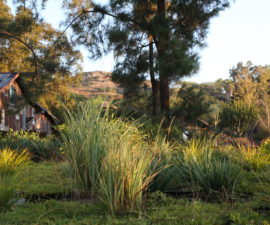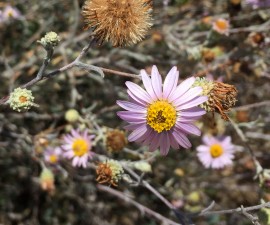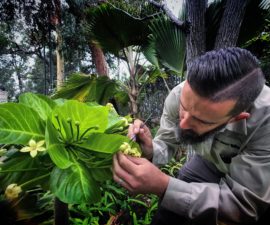BY kabrams
Photography by Ken Bohn
The dictionary defines browse as vegetation such as twigs, young leaves, or shoots eaten by animals. But to keepers at the San Diego Zoo and San Diego Zoo Safari Park, the term means much more.
Browse plays an integral part in the care of our animals, and we are extraordinarily lucky that the San Diego Zoo and the Safari Park have an excellent formal browse program. The system is successful because of the dedicated, knowledgeable, and hard-working crew that services our large and diverse animal collection. Our keepers enjoy the luxury of selecting browse from a barrel full of verdant, freshly cut vegetation delivered right to their area’s door, and the positive impact on our cherished animal collection is huge.

 Pounds of acacia delivered by the browse team yearly.
Pounds of acacia delivered by the browse team yearly.

Pounds of bamboo delivered by the browse team yearly.
Browsers’ Delight
Every morning at around 8 a.m., Bill Austin, a senior keeper, selects a single six-foot-long branch of acacia for each giraffe under his care. The boughs are stored on a shaded cement slab where an overhead misting system keeps them fresh. Bill hangs the branches from tall metal structures that hold them 16 feet aloft. In addition to the acacia, Bill has set out pellets and hay, yet as the giraffes enter the yard, each one makes a beeline for the browse—clearly the crowd favorite. First, they eat the leaves. Then the thin branches are devoured, and finally, the bark is meticulously stripped and consumed. All that remains is the woody structure of the branch, which we refer to as the “browse bones” and repurpose as enrichment, decoration, or “scratchers” for a variety of animal species.
Amy Alfrey, a senior keeper who cares for the koalas, considers herself to be “a real browse person.” The Zoo’s browse program takes on extra importance in Amy’s area because browse represents 100 percent of a koala’s diet. We feed our koalas 40 varieties of eucalyptus (a small subset of the 1,000 species grown here in San Diego), and each individual koala has a favorite. As keepers tie the eucalyptus clusters to the trees, they often have to scoot the koalas out of the way as they excitedly try to grab the fresh leaves!
It is always a pleasure to present browse to an animal, whether fresh greenery is just part of the menu, makes up the mainstay of the animal diet, or is presented for enrichment. For keepers and animals alike, the morning browse delivery is a special time of the day.

Filling Needs
The amount and variety of browse is staggering. The crew must start early to meet demand—the earliest shift begins promptly at 5 a.m. The plant material is harvested from the Zoo, the Park, specific residences, and three dedicated browse farms operated by San Diego Zoo Global. The greenery is cut and loaded, then transported to the grounds, where it is sorted for distribution to more than 33 locations at the Zoo alone. This complex task requires knowledge, organization, and flexibility, since our animal collection—and its needs—is ever changing.
Sirena Aboumrad, a browse specialist, is primarily responsible for providing specialty browse intended for our beautiful primate collection. Her job requires extra care, since most of the material is gathered from plants on Zoo grounds. To keep the plants looking good and producing properly, Sirena considers the growth cycle, aesthetics, and peak growth periods of all the plants she harvests.

 Pounds of eucalyptus delivered by the browse
Pounds of eucalyptus delivered by the browseteam yearly.

Pounds of ficus, acacia and other approved browse for the elephants delivered by the browse team yearly.
A Fresh Idea
One of Sirena’s goals is to provide the Zoo’s primate collection with the largest possible variety of browse. Recently, a florist-quality, walk-in cooler was installed in an off-exhibit area on Zoo grounds. Sirena proposed the idea, which would help her provide a larger variety of fresher material, deliver it in longer pieces (which many primates love!), and reduce our use of plastic. When Dean Gibson, curator of primates, heard about the plan and the benefits to the animal collection, she found the funds necessary to make it happen. Inside the treasured cooler, immaculately kept barrels filled with browse are kept chilled in a moist environment for maximum freshness.
Our horticulture department contributes much to the Zoo and the Park. In addition to the beautiful gardens and natural atmosphere that our plant collection provides, they help us provide outstanding care for our animal collection. Through the hard work and dedication of the browse team, our animals live a better life. They are provided with a vital, daily link to the natural world—a taste of the wild. Next time you find yourself out and about on grounds in the early morning, keep an eye out for the browse truck—you’ll know when you see it! Take the time to acknowledge the precious cargo it carries and the dedicated staff who is responsible for it.





